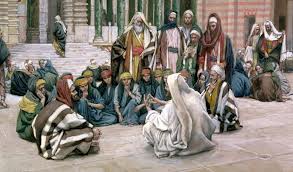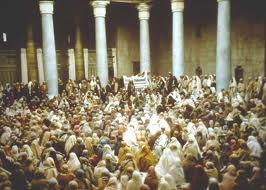They Walked with Jesus III
(Continued from Part II)The Temple and Old Jerusalem
After that session with Mary, Dolores wanted to do some research into that Temple that Mary had talked about. She went to a University Library, and what she found was a bit frustrating for her. She found that places such as the land where Jesus walked no longer exist, and even the very terrain and topography has changed. In Jesus’ time there were cliffs and valleys, and now the cliffs have washed down and the valleys are filled in. So what you would find now is more like hills. She expected to be able to find evidence of ruins from Jesus’ time, but she found that they were buried under approximately 100 feet of dirt, and that archaeologists don’t even know for sure exactly where to dig.
exist, and even the very terrain and topography has changed. In Jesus’ time there were cliffs and valleys, and now the cliffs have washed down and the valleys are filled in. So what you would find now is more like hills. She expected to be able to find evidence of ruins from Jesus’ time, but she found that they were buried under approximately 100 feet of dirt, and that archaeologists don’t even know for sure exactly where to dig.And so she found her information on the Temple in the writings of the scholars on the Bible and ancient historians. Now, the very interesting part of that is the Temple as described by the Bible scholars and the Temple as described by Mary/Abigail sound exactly like the same place.
Mary/Abigail’s description of the Temple:
…we dance up and down the steps. The stepsare very broad and spacious. They are deep and are very
long. This is just a wonderful spot. (Surprised) It’s not
unlike the grove. Ahhh! As the pillars and the overhang…
(merry laugh) the shadow, the cool, but the sunshine just
on the other side.
…it is a large temple. Open, tall columns, altars.
…The kingdom of God is within.
The temples are not to separate God from man. The
temples are to be a place of union. Man should be able to
come into the holy space, and invite God directly into his
heart. Not through sacrifices, not through intercessions,
but be allowed to stand on that holy ground and commune
directly with God.
…I believe he’s been at a different location on the Temple
steps than where I teach. It is as if it is a rectangle. I
would teach the children on the long side of the building.
He has stood on the narrow end, as you approach the
Temple.
…There must have been a wide step
that was a breakdown between two staircases where we

did that dance. The steps of the Temple weren’t like one
set of stairs. It was like a set of stairs and then a wide
landing, and then another set of stairs. So I think we did
that kind of dance on the wide landing.
…it is very big. Tall, high spaces. It is an… I hesitate to
use the word ‘intimidating’, but the size is remarkable.
Dolores Cannon’s research results describing the Temple:
According to Josephus, the walls of the outer Temple courtwere lined with porticoes, and the basilica on the south was
especially notable, having at least one hundred and sixty two
columns. Each pillar was a single block of the purest white
marble, and was so large that three men could just reach around
it with their arms extended. These four rows of pillars included
three spaces for walking in the middle of these cloisters. The
roofs were adorned with beautiful sculptures in cedar, and the
front was made of polished stone. This was the first thing
encountered after entering the gate through the massive outer
wall. From there the open court was paved with all manner of
stones.
 Beyond the basilica was a large outer court commonly
Beyond the basilica was a large outer court commonlyknown as the Court of the Gentiles. Although in the ancient
Temple of Solomon only Jews were admitted within the walls,
Herod felt that he must appropriate some part of the Sanctuary
for the use of strangers of all nations. This was because there
were many Egyptians, Greeks, Romans and members of other
nations resident in Jerusalem. Thus a large outer court was
constructed, open to all who wished to walk and converse in
this cloister, which was therefore called the Court of the
Gentiles. Adjoining this was the Court of the Israelites, into
which no Gentile was permitted to enter on any pretense
whatever. Josephus states that these two courts were separated
by a low wall or balustrade about four and a half feet high, with
thirteen entrances or openings. On the top of this partition small
square stone pillars were placed at intervals, each bearing an
inscription in Greek that no stranger should pass the wall, and
threatening death to any transgressor.
The Temple was a huge complex composed of various
courts, one leading into the other until the inner court and Holy
of Holies was reached. The people were allowed to enter each
court according to their worthiness and cleanliness. This was all
defined by the Law, or Mosaic set of rules. On the east side of
the Temple Mount was the Women’s Court. This was
approached by entering through a portico consisting of tall

pillars (called the Hall of Solomon), and then climbing a series
of terraced steps, because this area was sloped at more of an
angle than the rest of the Temple Mount. The steps led from
one area to the next, progressing from the Women’s Court up to
the main Temple area. Ancient historians say the flight of steps
was probably broken by two wide landings, with a third wide
step at the top of the flight. Possibly these steps extended the
whole length of the Porch.
Jewish men could go inside this area into the Women’s
Court. However, most women could not progress further
because they were considered to be unclean most of the time,
due to their menstrual periods and the after-effects of childbirth.
Certain men were also not allowed to go further into the inner
courts, if they had any type of infection or disease, or if they
had recently come in contact with a dead body. There were
many rules regarding the cleanliness of the people, and most
Jews fell within some of these categories at one time or another.
 Beyond the Women’s Court were several more into which
Beyond the Women’s Court were several more into whichonly certain people were allowed, until the final holy chamber
was reached. This east entrance to the Women’s Court was
distinguished by folding doors of Corinthian brass. Josephus
says that occasionally public gatherings took place in front of
them. They were so massive that it needed the combined
strength of twenty men to open and close them every day,
because it was unlawful to leave any of the Temple doors open.
There were nine other gates and doors to these inner courts that
were completely overlaid with massive plates of silver and
gold, as well as their doorposts and lintels. But the huge brass
gate far exceeded them in size and value.
In the Priests’ Court, and directly in front of the Temple
edifice proper was the altar upon which sacrifices and burnt
offerings were made. There was a series of rings in the floor
where the sacrificial animals were tethered to await their doom.
The area also contained eight marble tables on which the
carcasses were skinned, washed and prepared for the altar. The blood of the victims drained off through holes in the floor, and
the whole area around the altar resembled a butcher’s
slaughterhouse.
AV: There is much more in this section of the book, but I think I have put together the most relevant pieces here.
(To Be Continued…)

No comments:
Post a Comment